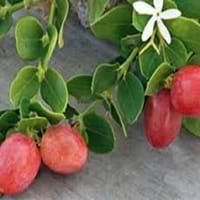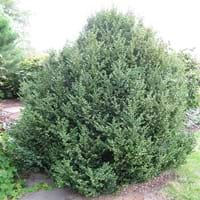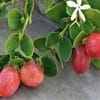Life Span
Perennial
Perennial
Type
Fruit
Broadleaf Evergreen
Origin
Central Asia, Southern Asia, Western Ghats, India
Hybrid origin
Types
congesta, paucinervia
Not Available
Number of Varieties
Not Available
Habitat
Fertile bottom land, moist forests, Temperate Regions, Tropical Forests
hedge rows, Shady Edge, Woodland Garden Dappled Shade
USDA Hardiness Zone
Not Available
6-9
AHS Heat Zone
8-3
Not Available
Sunset Zone
Not Available
21,22
Habit
Upright/Erect
Pyramidal
Flower Color
Pale White, White
Light Yellow
Flower Color Modifier
Bicolor
Bicolor
Fruit Color
Purple, Black
Not Available
Leaf Color in Spring
Green
Green, Dark Green
Leaf Color in Summer
Green
Dark Green
Leaf Color in Fall
Green
Dark Green
Leaf Color in Winter
Light Green
Dark Green
Plant Season
Spring, Summer, Fall
Spring, Summer, Fall, Winter
Sunlight
Full Sun, Partial Sun, Partial shade
Full Sun, Partial Sun
Growth Rate
Medium
Medium
Type of Soil
Loam
Loam, Sand
The pH of Soil
Acidic, Neutral, Alkaline
Acidic, Neutral
Soil Drainage
Well drained
Well drained
Tolerances
Drought
Pollution
Where to Plant?
Ground
Container, Ground, Pot
How to Plant?
Seedlings, Stem Cutting
Root Division, Stem Cutting
Plant Maintenance
Medium
Medium
Watering Requirements
Keep the ground moist but not water-logged
Needs more water during establishment, Never Over-water, occasional watering once established
In Summer
Lots of watering
Lots of watering
In Spring
Moderate
Moderate
In Winter
Average Water
Average Water
Soil pH
Acidic, Neutral, Alkaline
Acidic, Neutral
Soil Type
Loam
Loam, Sand
Soil Drainage Capacity
Well drained
Well drained
Sun Exposure
Full Sun, Partial Sun, Partial shade
Full Sun, Partial Sun
Pruning
Prune if you want to improve plant shape, Remove dead leaves
Prune ocassionally, Remove branches, Remove branches that rub together, Remove crossing or rubbing branches, Remove damaged leaves, Remove dead branches, Remove dead leaves, Remove dead or diseased plant parts
Fertilizers
Compost, fertilize in growing season
All-Purpose Liquid Fertilizer, Fertilize in early to mid-summer
Pests and Diseases
Aphids, Earwigs, Insects, Mildew, Red blotch, Rust, sawflies
Red blotch
Plant Tolerance
Dry soil, Heat And Humidity
Pollution
Flowers
Insignificant
Yes
Flower Petal Number
Single
Single
Foliage Texture
Medium
Fine
Foliage Sheen
Matte
Glossy
Attracts
Birds, Butterflies, Fruit Bats
Bees, Birds
Allergy
Eczema, Mouth itching, Throat itching
Poisonous
Aesthetic Uses
Not Available
Used for making hedges
Beauty Benefits
good for lips, Remove blemishes
Not Available
Environmental Uses
Air purification, Food for animals, Food for birds, soil stabilisation
Air purification
Medicinal Uses
Anemia, Diuretic, Potassium, Rich in Iron, Vitamin C
Alterative, Antirheumatic, Arthritis, cathartic, Cholagogue, Detoxification, Diaphoretic, Febrifuge, HIV/AIDS, Homeopathy, Immunity, Odontalgic, Sedative, Tonic, Vermifuge
Part of Plant Used
Fruits, Leaves
Flowers, Leaves, Wood
Other Uses
Added to salads, Cosmetics, Culinary use, Used as a nutritious food item, Used As Food, Used for its medicinal properties
Used as a dye, Used for woodware
Used As Indoor Plant
No
Yes
Used As Outdoor Plant
Yes
Yes
Garden Design
Edible, Fruit / Fruit Tree, Hedges
Container, Edging, Feature Plant, Foundation, Hedges, Mixed Border
Botanical Name
Carissa carandas
BUXUS 'Green Mountain' COPF
Common Name
Black Currant
Boxwood, Green Mountain Boxwood
In Hindi
करोंदा, कालि मैना
Buxus Green Mountain Tree
In German
Carandas
Buxus Green Mountain Baum
In French
karondas
Buxus Green Tree Montagne
In Spanish
karondas
Buxus árbol verde de la montaña
In Greek
karondas
Buxus Green Mountain Tree
In Portuguese
karondas
Buxus Árvore verde da montanha
In Polish
karondas
Buxus Green Mountain Drzewo
In Latin
karondas
Buxus Viridis ligno
Phylum
Magnoliophyta
Magnoliophyta
Class
Magnoliopsida
Magnoliopsida
Order
Gentianales
Euphorbiales
Family
Apocynaceae
Buxaceae
Clade
Angiosperms, Asterids, Eudicots
Angiosperms, Eudicots
Tribe
Not Available
Not Available
Subfamily
Not Available
Not Available
Number of Species
Not Available
Season and Care of Karonda and Buxus Green Mountain
Season and care of Karonda and Buxus Green Mountain is important to know. While considering everything about Karonda and Buxus Green Mountain Care, growing season is an essential factor. Karonda season is Spring, Summer and Fall and Buxus Green Mountain season is Spring, Summer and Fall. The type of soil for Karonda is Loam and for Buxus Green Mountain is Loam, Sand while the PH of soil for Karonda is Acidic, Neutral, Alkaline and for Buxus Green Mountain is Acidic, Neutral.
Karonda and Buxus Green Mountain Physical Information
Karonda and Buxus Green Mountain physical information is very important for comparison. Karonda height is 120.00 cm and width 120.00 cm whereas Buxus Green Mountain height is 152.40 cm and width 91.44 cm. The color specification of Karonda and Buxus Green Mountain are as follows:
Karonda flower color: Pale White and White
Karonda leaf color: Green
Buxus Green Mountain flower color: Light Yellow
- Buxus Green Mountain leaf color: Green and Dark Green
Care of Karonda and Buxus Green Mountain
Care of Karonda and Buxus Green Mountain include pruning, fertilizers, watering etc. Karonda pruning is done Prune if you want to improve plant shape and Remove dead leaves and Buxus Green Mountain pruning is done Prune ocassionally, Remove branches, Remove branches that rub together, Remove crossing or rubbing branches, Remove damaged leaves, Remove dead branches, Remove dead leaves and Remove dead or diseased plant parts. In summer Karonda needs Lots of watering and in winter, it needs Average Water. Whereas, in summer Buxus Green Mountain needs Lots of watering and in winter, it needs Average Water.





